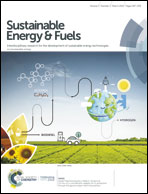Ce–Sm–xCu cost-efficient catalysts for H2 production through the glycerol steam reforming reaction
Abstract
A series of Ce–Sm–xCu (x = 5, 7, and 10 at%) catalysts were prepared through coupling of microwave irradiation with a sol–gel method and were evaluated for the glycerol steam reforming reaction in the 400–750 °C temperature range. Some critical comparison with co-precipitation catalysts is also discussed. The catalysts were characterized using BET, Raman, XRD, NH3-TPD, CO2-TPD, H2-TPR, SEM, HAADF-STEM and XPS analyses, while the bonding environment and thermal stability of the catalyst precursor compounds were studied using FTIR and TGA/DSC. For all catalysts it was found that the Ce, Sm, and Cu cations are all homogeneously distributed in the cubic fluorite cell with interplanar spacings of 0.355 nm, 0.370 nm and 0.373 nm for the Ce–Sm–5Cu, Ce–Sm–7Cu and Ce–Sm–10Cu catalysts, respectively. The surface of the catalysts was found to be Ce- and Cu-poor and Sm-rich, with Ce4+, Ce3+, Sm3+, Cu2+ and Cu+ oxidation states identified. In the bulk, the oxygen vacancies were found to be dependent on the catalyst composition (Cu content). Among the catalysts studied, the Ce–Sm–5Cu one exhibits the highest selectivity for hydrogen (H2) with its SH2 ranging from 40% (400 °C) to 75% (750 °C). The Ce–Sm–5Cu catalyst also produces the highest amount of CO (97–71%) and the lowest amount of CO2 (3–28%) among all samples for the low reaction temperature range (400 °C < T < 600 °C). For all catalysts, the CO/CO2 molar ratio is quite low (<7.0) in the whole temperature range, while the H2/CO molar ratio value remains almost stable (∼2.0) for 400 °C < T < 600 °C; it increases sharply for T > 650 °C and reaches values of 7, 10 and 12 for the samples Ce–Sm–5Cu, Ce–Sm–7Cu, and Ce–Sm–10Cu, respectively. All the catalysts showed a glycerol conversion of 80% after 6 h time on stream, although a variety of coke species was found on their surfaces. A potential correlation between Cu content and coke deposition was attempted.



 Please wait while we load your content...
Please wait while we load your content...